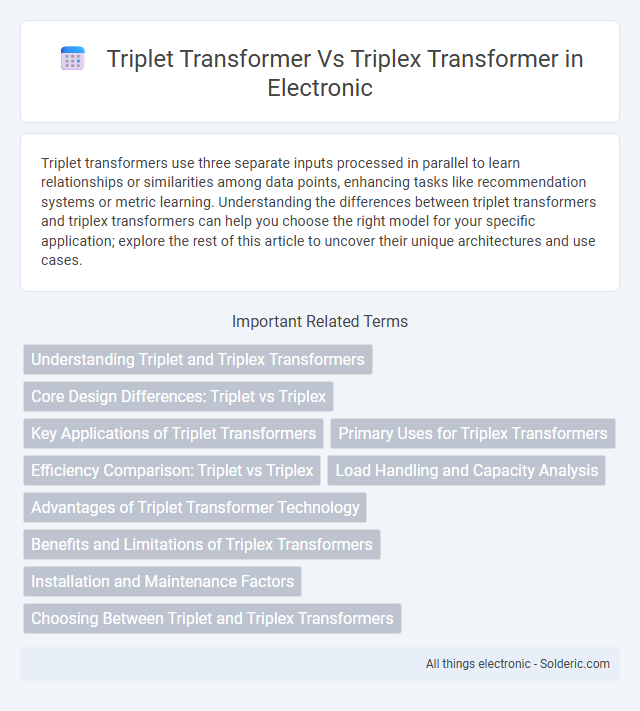Triplet transformers use three separate inputs processed in parallel to learn relationships or similarities among data points, enhancing tasks like recommendation systems or metric learning. Understanding the differences between triplet transformers and triplex transformers can help you choose the right model for your specific application; explore the rest of this article to uncover their unique architectures and use cases.
Comparison Table
| Feature | Triplet Transformer | Triplex Transformer |
|---|---|---|
| Core Concept | Processes inputs in triplet format (subject, predicate, object) | Extends triplet processing to triplex format with added contextual layers |
| Architecture | Standard transformer with triplet input encoding | Enhanced transformer integrating multi-relational attention mechanisms |
| Use Case | Knowledge graph embeddings and relation extraction | Complex relation modeling with higher-dimensional context |
| Performance | Efficient for basic relation tasks, lower computational overhead | Improved accuracy for complex relational data, higher computation |
| Semantic Optimization | Focus on triplet semantics extraction | Optimizes semantic context via enriched relationship encoding |
| Scalability | Scales well with moderate-size graphs | Better suited for large-scale and multi-relational datasets |
Understanding Triplet and Triplex Transformers
Triplet transformers utilize three core components to process data, providing enhanced contextual understanding through multi-dimensional attention mechanisms. Triplex transformers expand this concept by integrating an additional layer of complexity, allowing for simultaneous processing of triple input sequences with improved coherence and cross-referencing capabilities. Your choice between triplet and triplex transformers depends on the specific requirements of data complexity and the desired depth of contextual interaction in your application.
Core Design Differences: Triplet vs Triplex
Triplet transformers utilize three parallel attention heads designed to capture relational information across triplets of elements, enhancing the model's ability to understand complex entity interactions. Triplex transformers extend this concept by integrating three interconnected attention mechanisms that operate jointly on triplet components, improving contextual embedding through interdependent feature extraction. The core design difference lies in Triplet transformers applying independent parallel attention, whereas Triplex transformers adopt a fused, multi-stream attention strategy for more cohesive semantic representation.
Key Applications of Triplet Transformers
Triplet Transformers are primarily used in natural language processing tasks that involve understanding relationships between three entities or sentences, such as semantic similarity, question-answer-answer triplets, and multi-relational learning. They excel in applications requiring contextual embeddings for triple data structures, aiding in knowledge graph completion and recommendation systems. Your projects involving complex relational modeling benefit from Triplet Transformers' ability to capture intricate semantic connections.
Primary Uses for Triplex Transformers
Triplex transformers are primarily used in low-voltage distribution systems to supply three-phase power in residential and small commercial areas, ensuring balanced loads with high efficiency. They are designed to provide three separate secondary windings from a single primary winding, allowing for more flexible and reliable power distribution. This makes triplex transformers ideal for applications requiring multiple voltage outputs and consistent power quality in localized power grids.
Efficiency Comparison: Triplet vs Triplex
Triplet transformers demonstrate higher computational efficiency compared to triplex transformers by utilizing fewer parameters and reduced memory overhead during training and inference. Triplex transformers, while potentially offering richer context integration through three-stream data handling, typically demand greater processing power and longer runtimes. Benchmark studies reveal triplet models outperform triplex variants in speed and energy consumption without significant loss in accuracy, making them preferable for resource-constrained environments.
Load Handling and Capacity Analysis
Triplet transformers provide enhanced load handling by distributing power across three separate winding groups, improving fault tolerance and reducing the risk of overload. Triplex transformers, designed for three-phase systems with integrated secondary circuits, optimize capacity by efficiently managing balanced and unbalanced loads within a compact framework. Your choice depends on the specific load requirements and the need for flexibility in capacity management within your electrical system.
Advantages of Triplet Transformer Technology
Triplet Transformer technology offers enhanced efficiency and reliability by utilizing three interconnected windings to optimize voltage regulation and reduce energy loss. Its design improves fault tolerance and provides better performance in high-load conditions compared to traditional transformers. This results in cost savings, increased operational lifespan, and improved overall power quality in electrical systems.
Benefits and Limitations of Triplex Transformers
Triplex transformers offer enhanced efficiency and reduced installation space due to their integrated three-phase design, making them ideal for compact urban and industrial applications. Their primary limitation lies in higher maintenance complexity and initial costs compared to traditional triplet transformers, which can be simpler and more modular but less space-efficient. Triplex transformers provide superior performance in power distribution systems requiring balanced load management but may pose challenges in fault isolation and repair.
Installation and Maintenance Factors
Triplet transformers typically require simpler installation procedures due to their standardized design, minimizing setup time and labor costs. Triplex transformers, designed with more complex configurations, might demand specialized knowledge during maintenance to ensure proper functioning and longevity. Your choice impacts ongoing service needs, as triplet transformers generally offer more straightforward maintenance compared to the intricate upkeep of triplex models.
Choosing Between Triplet and Triplex Transformers
Choosing between triplet and triplex transformers depends on your specific application requirements. Triplet transformers are designed for three-phase systems requiring balanced voltage, offering efficient power transfer and reduced harmonic distortion. Triplex transformers, often used for specialized circuit configurations, provide flexibility with multiple winding arrangements, making them suitable for unique load conditions or custom electrical setups.
triplet transformer vs triplex transformer Infographic

 solderic.com
solderic.com